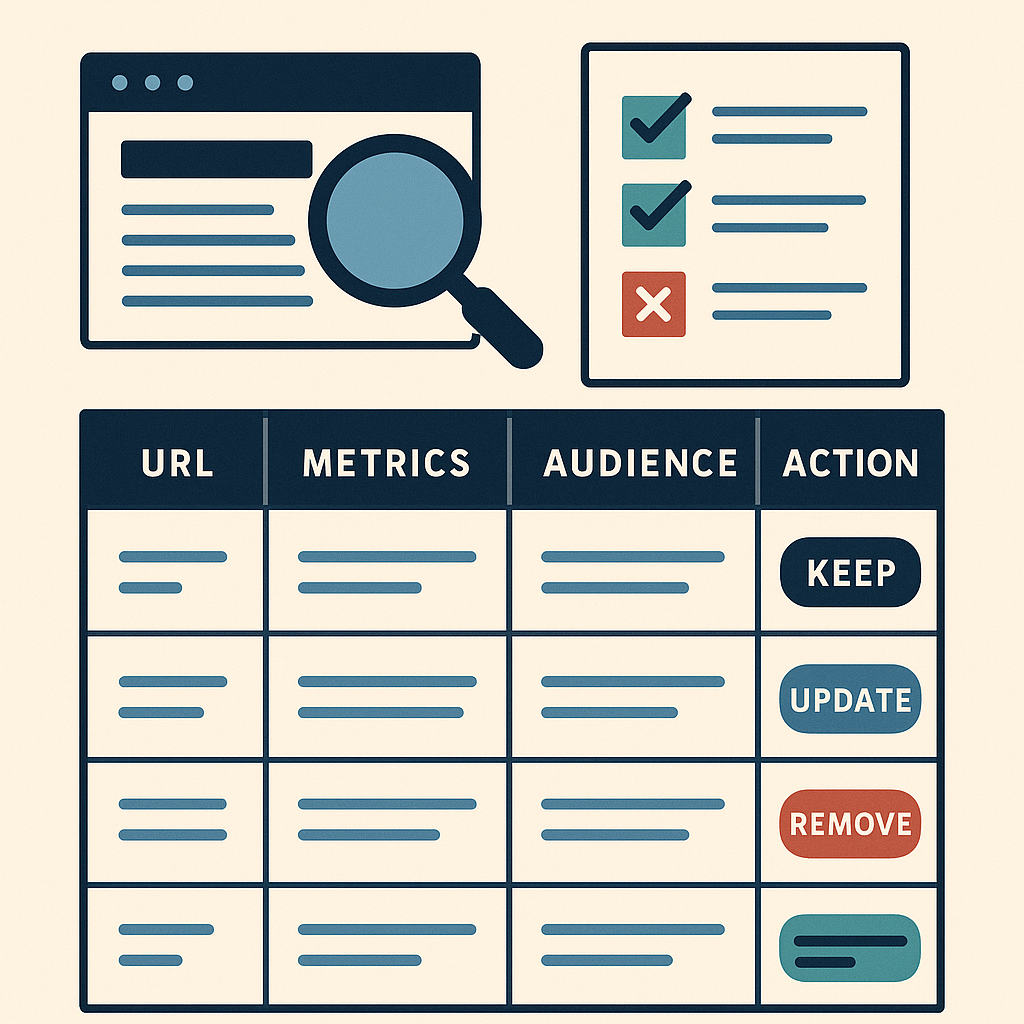Your B2B website is working around the clock, but is it working effectively? If you’re like most content marketers and demand generation managers, you’ve been adding blog posts, case studies, whitepapers, and landing pages for months or even years. But when was the last time you took a step back to evaluate what’s actually performing—and what’s dragging your site down?
A comprehensive website content audit isn’t just spring cleaning for your digital presence. It’s a strategic exercise that can uncover hidden opportunities, eliminate content that’s hurting your SEO, and align your entire content ecosystem with your current business goals. Whether you’re a seasoned content strategist at an agency or a demand gen manager looking to optimize your site’s performance, this step-by-step guide will walk you through the entire process.

Why Your B2B Website Needs a Content Audit (And Why Now)
The average B2B website accumulates content like a digital attic. Product pages multiply as your offerings evolve. Blog posts pile up from various campaigns and initiatives. Landing pages get created for specific campaigns and then forgotten. Before you know it, you’re sitting on hundreds or even thousands of pages—some driving results, others creating digital dead weight.
Here’s what happens when you skip regular content audits: duplicate content confuses search engines and dilutes your authority, outdated information damages your credibility with prospects, poor-performing pages drag down your domain’s overall SEO performance, and your content team wastes time promoting pieces that will never convert.
The solution isn’t to panic and delete everything. It’s to approach your content systematically, with clear criteria for what stays, what goes, and what needs improvement.
Phase 1: Preparation and Goal Setting
Before you dive into spreadsheets and analytics, take a moment to define what success looks like for your audit. Are you primarily focused on improving organic search performance? Looking to align content with new buyer personas? Preparing for a website redesign? Your goals will shape every decision you make during the audit process.
Start by gathering your team and stakeholders. You’ll want input from content creators, SEO specialists, sales teams, and anyone else who interacts with prospects through your website. Each perspective will reveal different insights about what’s working and what isn’t.
Next, establish your evaluation criteria. While these will vary based on your goals, most B2B content audits should consider traffic and engagement metrics, conversion performance, SEO factors like keyword rankings and backlinks, content freshness and accuracy, and alignment with current messaging and positioning.
Document these criteria clearly—you’ll reference them constantly throughout the audit process.
Phase 2: Creating Your Content Inventory Template
The foundation of any effective website content audit is a comprehensive inventory. This isn’t just a list of URLs; it’s a detailed catalog that captures every piece of information you’ll need to make informed decisions about each page.
Your content inventory template should include basic information like URL, page title, publication date, and last updated date. You’ll also want to capture performance metrics including organic traffic, page views, bounce rate, average time on page, and conversion data. Don’t forget technical SEO elements such as meta descriptions, title tags, header structure, and internal/external links.
Content classification is equally important. Tag each piece by content type (blog post, case study, product page, etc.), target audience or buyer persona, funnel stage (awareness, consideration, decision), and primary topic or theme.
Finally, include space for qualitative assessments. This might include content quality ratings, brand alignment scores, and notes about potential improvements or concerns.
Setting up this content inventory template properly will save you hours of work later and ensure you don’t miss critical insights during your analysis.
Phase 3: Data Collection and Analysis
Now comes the systematic work of populating your inventory. Start with your sitemap or use crawling tools to generate a comprehensive list of all pages on your site. Don’t forget about orphaned pages that might not appear in your main navigation but still exist and potentially rank in search engines.
For each page, gather the quantitative data first. Export analytics data for metrics like page views, unique visitors, bounce rate, and conversion events. Pull SEO data including current keyword rankings, backlinks, and technical issues. If you’re using marketing automation platforms, include lead generation and progression data as well.
The qualitative assessment requires more subjective judgment, but it’s equally important. As you review each piece of content, ask yourself: Does this content reflect our current positioning and messaging? Is the information accurate and up-to-date? Would I be proud to send this to a prospect? Does it provide genuine value to our target audience?
This is also when you’ll start to notice patterns. You might discover that certain content types consistently outperform others, or that pages targeting specific buyer personas generate higher-quality leads. Pay attention to these trends—they’ll inform your content strategy moving forward.
Phase 4: Content Categorization and Decision Making
With your data collected, it’s time to make decisions. Most content audits use a simple categorization system: Keep, Improve, Merge, or Delete. Some teams add a fifth category: Redirect.
Keep these pages as they are—they’re performing well and align with your current strategy. These are typically your highest-traffic pages, best converters, or pieces that perfectly represent your brand and expertise.
Improve content that has potential but needs work. This might include updating outdated information, optimizing for SEO, improving the user experience, or aligning messaging with current positioning. High-traffic pages with poor conversion rates often fall into this category.
Merge similar or duplicate content into stronger, more comprehensive pieces. B2B sites often accumulate multiple blog posts on similar topics or product pages that could be consolidated for better SEO performance.
Delete content that’s beyond saving—outdated, off-brand, or simply not worth the effort to improve. This is often the hardest decision for content creators, but removing low-quality content can actually boost your site’s overall performance.
Redirect pages that still have SEO value (backlinks, rankings) but don’t align with your current strategy. Rather than deleting them and losing that authority, redirect the traffic to more relevant, current pages.
Phase 5: B2B Site Optimization and Implementation
Your audit is only valuable if you act on the insights. Start by prioritizing your improvements based on potential impact and required effort. Quick wins might include updating meta descriptions, fixing broken links, or refreshing outdated statistics. Larger projects could involve rewriting entire sections or consolidating multiple pages.
For pages in the “Improve” category, create detailed action plans. If a high-traffic blog post has a poor conversion rate, consider adding more compelling calls-to-action, updating the content to address current pain points, or improving the user experience with better formatting and visuals.
When merging content, don’t just copy and paste. Take the opportunity to create something better than the sum of its parts. Combine the best elements from each piece, update the information, and structure it in a way that serves your audience better.
For deletions and redirects, move carefully. Set up proper 301 redirects to preserve any SEO value, and monitor your analytics to ensure you haven’t accidentally removed something important.
Measuring Success and Ongoing Maintenance
A content audit isn’t a one-time project—it’s the beginning of a more strategic approach to content management. Set up systems to monitor the impact of your changes. Track improvements in organic traffic, conversion rates, and user engagement for the pages you’ve optimized.
Create a schedule for regular content reviews. High-growth B2B companies should audit their content quarterly, while more established organizations might do comprehensive audits annually with smaller reviews throughout the year.
Document your process and findings. Future audits will be much more efficient if you can build on previous work rather than starting from scratch each time.
Tools and Resources to Streamline Your Audit
While you can conduct a content audit with basic tools, the right software can significantly speed up the process and improve accuracy. Google Analytics and Google Search Console provide essential traffic and SEO data. Screaming Frog or similar crawling tools can quickly identify technical issues and generate comprehensive site inventories.
For larger sites, consider platforms like SEMrush, Ahrefs, or Moz that can automate much of the data collection process. Content management platforms like ContentKing or BrightEdge offer ongoing monitoring that can alert you to issues before they become problems.
Moving Forward with Confidence
A thorough website content audit reveals the true state of your digital presence—both the opportunities and the challenges. It’s normal to feel overwhelmed by the findings, especially if you’ve never conducted one before. Remember that every piece of content on your site was created with good intentions, but not every piece deserves to stay.
The goal isn’t perfection; it’s improvement. Focus on making meaningful progress rather than trying to fix everything at once. Your audience will notice the difference, your search rankings will improve, and your content team will have a clearer direction for future efforts.
Most importantly, use this audit as a foundation for ongoing content governance. The insights you’ve gained about what works and what doesn’t should inform every content decision moving forward. Your website will become a more effective sales and marketing tool, and your team will have the confidence that comes from knowing exactly what’s driving results.
Your B2B website content audit isn’t just about cleaning house—it’s about building a content ecosystem that works as hard as you do to drive business results.
